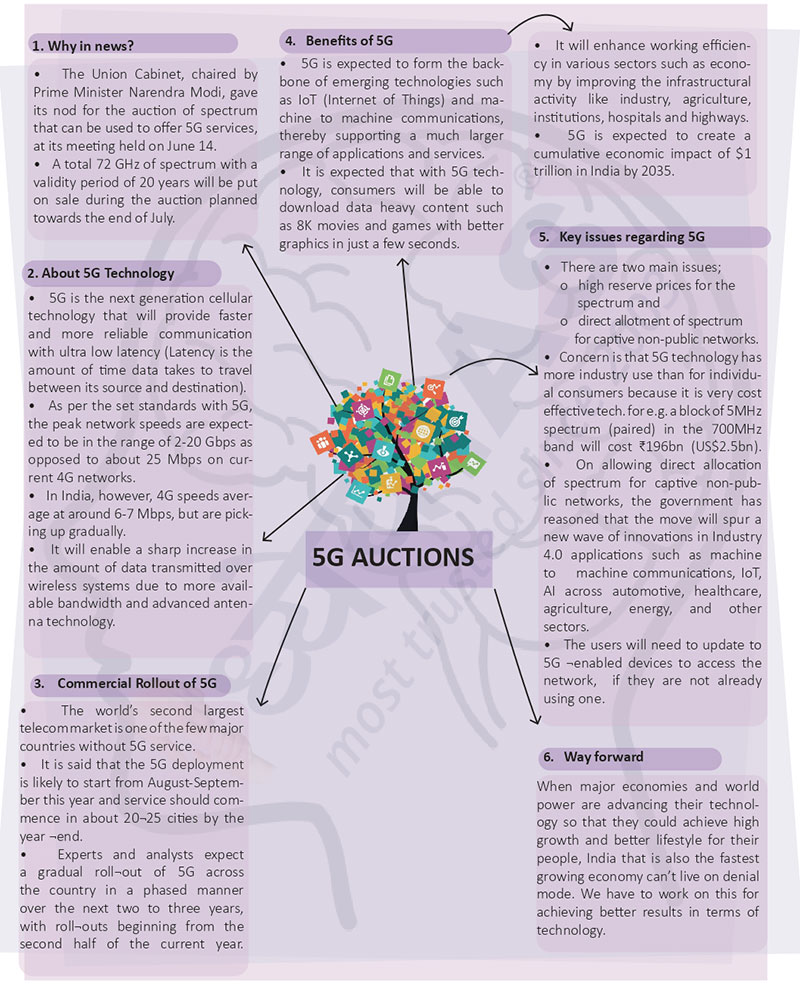Brain-booster /
11 Jul 2022
Brain Booster for UPSC & State PCS Examination (Topic: 5G Auctions)

Why in news?
- The Union Cabinet, chaired by Prime Minister Narendra Modi, gave its nod
for the auction of spectrum that can be used to offer 5G services, at its
meeting held on June 14.
- A total 72 GHz of spectrum with a validity period of 20 years will be
put on sale during the auction planned towards the end of July.
About 5G Technology
- 5G is the next generation cellular technology that will provide faster
and more reliable communication with ultra low latency (Latency is the
amount of time data takes to travel between its source and destination).
- As per the set standards with 5G, the peak network speeds are expected
to be in the range of 2-20 Gbps as opposed to about 25 Mbps on current 4G
networks.
- In India, however, 4G speeds average at around 6-7 Mbps, but are picking
up gradually.
- It will enable a sharp increase in the amount of data transmitted over
wireless systems due to more available bandwidth and advanced antenna
technology.
Commercial Rollout of 5G
- The world’s second largest telecom market is one of the few major
countries w ithout 5G ser vice.
- It is said that the 5G deployment is likely to start from
August-September this year and service should commence in about 20¬25 cities
by the year ¬end.
- Experts and analysts expect a gradual roll¬out of 5G across the country
in a phased manner over the next two to three years, with roll¬outs
beginning from the second half of the current year.
Benefits of 5G
- 5G is expected to form the backbone of emerging technologies such as IoT
(Internet of Things) and machine to machine communications, thereby
supporting a much larger range of applications and services.
- It is expected that with 5G technology, consumers will be able to
download data heavy content such as 8K movies and games with better graphics
in just a few seconds.
- It will enhance working efficiency in various sectors such as economy by
improving the infrastructural activity like industry, agriculture,
institutions, h ospitals a nd h ighways.
- 5G is expected to create a cumulative economic impact of $1 trillion in
In dia b y 2035.
Key issues regarding 5G
- There are two main issues;
- high reserve prices for the spectrum and
- direct allotment of spectrum for captive non-public networks.
- Concern is that 5G technology has more industry use than for individual
consumers because it is very cost effective tech. for e.g. a block of 5MHz
spectrum (paired) in the 700MHz band will cost ₹196bn (US$2.5bn).
- On allowing direct allocation of spectrum for captive non-public
networks, the government has reasoned that the move will spur a new wave of
innovations in Industry 4.0 applications such as machine to machine
communications, IoT, AI across automotive, healthcare, agriculture, energy,
and other sectors.
- The users will need to update to 5G ¬enabled devices to access the
network, if they are not already using one.
Way forward
- When major economies and world power are advancing their technology so
that they could achieve high growth and better lifestyle for their people,
India that is also the fastest growing economy can’t live on denial mode. We
have to work on this for achieving better results in terms of technology.









